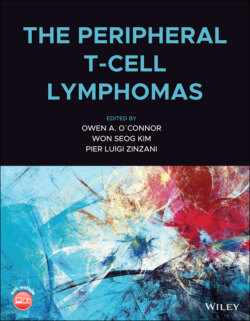Читать книгу The Peripheral T-Cell Lymphomas - Группа авторов - Страница 63
BET Inhibitors
ОглавлениеBromodomains are protein motifs that recognize and bind to acetylated lysine moieties located on histone tails. BETs consist of two amino‐terminal tandem bromodomains and an extra‐terminal (non‐bromodomain) region. The BET family includes BRD2, BRD3 and BRD4 and bromodomain testis‐specific protein [118]. Upon binding to acetylated lysine groups, BETs induce gene expression either directly by recruiting transcription factors to DNA and initiating transcription or indirectly by interacting with gene super‐enhancers (non‐coding regions of DNA that bind to transcription factors and activate nearby target genes controlling cellular identity). Thus, BETs contribute to the development and progression of malignancies by both activating and potentiating the expression of key oncogenes [119].
Although BET mutations or translocations are rare, BETs can be overexpressed [120]. Consequently, BET inhibition has been shown to be effective in preclinical studies across multiple types of cancers, including breast, neuroendocrine, ovarian, and hematological malignancies, as well as in rhabdomyosarcoma and glioma [121–125]. BET inhibitors appear to be active in CTCL, EBV‐associated lymphoproliferative disease and primary effusion lymphoma and have been shown to decrease the rate of tumor growth and disease progression in mouse xenograft models [126–128]. Several phase I trials designed to test BET inhibitors, including molibresib, CC‐90010, and INCB054329, are currently ongoing for patients with various advanced‐stage malignancies. In December 2018, data from 27 patients with various subtypes of non‐Hodgkin lymphoma treated with molibresib were presented at the American Society of Hematology annual meeting. The overall response rate among the entire cohort was 18.5%, with one patient with DLBCL having a sustained complete remission after receiving treatment for 54 weeks. Also of note, three of six patients with TCL had a partial response [129]. However, at the time of writing no further studies with molibresib were planned for lymphoma.
